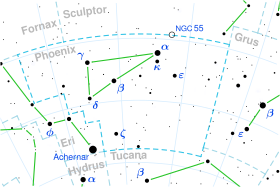Delta Phoenicis
| Observation data Epoch J2000 Equinox J2000 | |
|---|---|
| Constellation | Phoenix |
| Right ascension | 01h 31m 15.10475s[1] |
| Declination | −49° 04′ 21.7308″[1] |
| Apparent magnitude (V) | 3.93[2] |
| Characteristics | |
| Evolutionary stage | Red clump[3] |
| Spectral type | G8.5 IIIb[2] |
| U−B color index | +0.70[4] |
| B−V color index | +0.99[4] |
| Astrometry | |
| Radial velocity (Rv) | −7.3±0.7[5] km/s |
| Proper motion (μ) | RA: +138.38[1] mas/yr Dec.: +153.89[1] mas/yr |
| Parallax (π) | 22.95 ± 0.19 mas[1] |
| Distance | 142 ± 1 ly (43.6 ± 0.4 pc) |
| Absolute magnitude (MV) | 0.73[2] |
| Details[3] | |
| Mass | 1.47±0.14 M☉ |
| Radius | 10.79±0.54 R☉ |
| Luminosity | 54.6±0.6 L☉ |
| Surface gravity (log g) | 2.61±0.10 cgs |
| Temperature | 4,790±10 K |
| Metallicity [Fe/H] | −0.28±0.10 dex |
| Rotational velocity (v sin i) | < 1.0[6] km/s |
| Age | 2.33±0.51 Gyr |
| Other designations | |
| Database references | |
| SIMBAD | data |
Delta Phoenicis, Latinized from δ Phoenicis, is a single,[7] yellow-hued star in the southern constellation of Phoenix. With an apparent visual magnitude of 3.93,[2] it is visible to the naked eye. Based upon an annual parallax shift of 22.95 mas as seen from Earth,[1] it is located 142 light years from the Sun. The star is moving closer to the Sun with a radial velocity of −7 km/s.[5]
This is a G-type giant star with a stellar classification of G8.5 IIIb.[2] It is a red clump star, which means it has reached the stage of its evolution where it is generating energy through helium fusion at its core.[8] It is around 2.3 billion years old with 1.47 times the mass of the Sun. The star is radiating 55 times the Sun's luminosity from its enlarged photosphere at an effective temperature of 4,790 K.[3]
References
[edit]- ^ a b c d e f Van Leeuwen, F. (2007). "Validation of the new Hipparcos reduction". Astronomy and Astrophysics. 474 (2): 653–664. arXiv:0708.1752. Bibcode:2007A&A...474..653V. doi:10.1051/0004-6361:20078357. S2CID 18759600. Vizier catalog entry
- ^ a b c d e Anderson, E.; Francis, Ch. (2012). "XHIP: An extended hipparcos compilation". Astronomy Letters. 38 (5): 331. arXiv:1108.4971. Bibcode:2012AstL...38..331A. doi:10.1134/S1063773712050015. S2CID 119257644. Vizier catalog entry
- ^ a b c Gallenne, A.; Pietrzyński, G.; Graczyk, D.; Nardetto, N.; Mérand, A.; Kervella, P.; Gieren, W.; Villanova, S.; Mennickent, R. E.; Pilecki, B. (2018-08-01), "Fundamental properties of red-clump stars from long-baseline H-band interferometry", Astronomy & Astrophysics, 616: A68, arXiv:1806.09572, Bibcode:2018A&A...616A..68G, doi:10.1051/0004-6361/201833341, ISSN 0004-6361
- ^ a b Mallama, A. (2014). "Sloan Magnitudes for the Brightest Stars". The Journal of the American Association of Variable Star Observers. 42 (2): 443. Bibcode:2014JAVSO..42..443M.Vizier catalog entry
- ^ a b Gontcharov, G. A. (2006). "Pulkovo Compilation of Radial Velocities for 35 495 Hipparcos stars in a common system". Astronomy Letters. 32 (11): 759–771. arXiv:1606.08053. Bibcode:2006AstL...32..759G. doi:10.1134/S1063773706110065. S2CID 119231169.
- ^ De Medeiros, J. R.; Alves, S.; Udry, S.; Andersen, J.; Nordström, B.; Mayor, M. (2014). "A catalog of rotational and radial velocities for evolved stars". Astronomy & Astrophysics. 561: A126. arXiv:1312.3474. Bibcode:2014A&A...561A.126D. doi:10.1051/0004-6361/201220762. S2CID 54046583. Vizier catalog entry
- ^ Eggleton, P. P.; Tokovinin, A. A. (September 2008). "A catalogue of multiplicity among bright stellar systems". Monthly Notices of the Royal Astronomical Society. 389 (2): 869–879. arXiv:0806.2878. Bibcode:2008MNRAS.389..869E. doi:10.1111/j.1365-2966.2008.13596.x. S2CID 14878976.
- ^ Liu, Y. J.; Zhao, G.; Shi, J. R.; Pietrzynski, G.; Gieren, W. (2007). "The abundances of nearby red clump giants". Monthly Notices of the Royal Astronomical Society. 382 (2): 553. Bibcode:2007MNRAS.382..553L. doi:10.1111/j.1365-2966.2007.11852.x.

